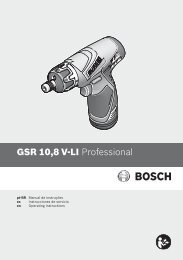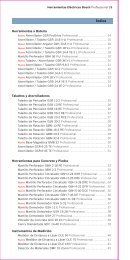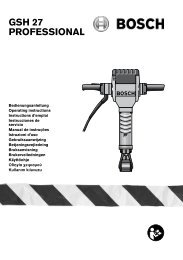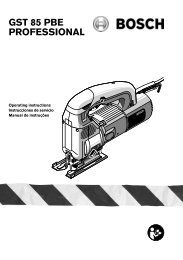GST 75 BE Professional
GST 75 BE Professional
GST 75 BE Professional
Create successful ePaper yourself
Turn your PDF publications into a flip-book with our unique Google optimized e-Paper software.
20 | English<br />
Assembly<br />
Before any work on the machine itself, pull<br />
the mains plug.<br />
Replacing/Inserting the Saw Blade<br />
When mounting the saw blade, wear protective<br />
gloves. Danger of injury when touching<br />
the saw blade.<br />
Selecting a Saw Blade<br />
An overview of recommended saw blades can<br />
be found at the end of these instructions. Use<br />
only T-shank saw blades. The saw blade should<br />
not be longer than required for the intended cut.<br />
Use a thin saw blade for narrow curve cuts.<br />
Inserting the Saw Blade (see figure A)<br />
If required, remove the dust cover 12 (see “Dust<br />
Cover”).<br />
Insert the saw blade 10 into the stroke rod 13<br />
until it latches. The SDS lever 14 automatically<br />
snaps to the rear and the saw blade is locked.<br />
Do not manually press the lever 14 toward the<br />
rear, otherwise you could damage the machine.<br />
While inserting the saw blade, pay attention that<br />
the back of the saw blade is positioned in the<br />
groove of the guide roller 9.<br />
Check the tight seating of the saw blade. A<br />
loose saw blade can fall out and lead to injuries.<br />
Ejecting the Saw Blade (see figure B)<br />
When ejecting the saw blade, hold the machine<br />
in such a manner that no persons or<br />
animals can be injured by the ejected saw<br />
blade.<br />
Turn the SDS lever 14 toward the front in the direction<br />
of the contact protector 11. The saw<br />
blade is released and ejected.<br />
Dust/Chip Extraction<br />
Dusts from materials such as lead-containing<br />
coatings, some wood types, minerals and<br />
metal can be harmful to one’s health. Touching<br />
or breathing-in the dusts can cause allergic<br />
reactions and/or lead to respiratory infections<br />
of the user or bystanders.<br />
Certain dusts, such as oak or beech dust, are<br />
considered as carcinogenic, especially in<br />
connection with wood-treatment additives<br />
(chromate, wood preservative). Materials<br />
containing asbestos may only be worked by<br />
specialists.<br />
– Use dust extraction whenever possible.<br />
– Provide for good ventilation of the working<br />
place.<br />
– It is recommended to wear a P2 filterclass<br />
respirator.<br />
Observe the relevant regulations in your<br />
country for the materials to be worked.<br />
Dust Cover<br />
Mount the dust cover 12 before connecting the<br />
machine to the dust extraction.<br />
Place the dust cover from the front into the<br />
guide so that it latches.<br />
Remove the dust cover for applications without<br />
dust extraction as well as when performing mitre<br />
cuts. For this, lightly push the end of the dust<br />
cover together and pull it off to the front.<br />
Connecting the Dust Extraction<br />
(see figures C–D)<br />
Depending on the machine model, place a vacuum<br />
hose 15 (accessory) either directly onto the<br />
vacuum connection 5 or cut off the old hose<br />
end, screw the extraction adapter 16 (accessory)<br />
onto the hose end and insert it directly into<br />
the vacuum connection 5. Connect the vacuum<br />
hose 15 with a vacuum cleaner (accessory). An<br />
overview for the connection of various vacuum<br />
cleaners can be found at the end of these instructions.<br />
Switch the saw dust blower off when a dust extraction<br />
system is connected (see “Sawdust<br />
Blower Device”).<br />
The vacuum cleaner must be suitable for the material<br />
being worked.<br />
When vacuuming dry dust that is especially detrimental<br />
to health or carcinogenic, use a special<br />
vacuum cleaner.<br />
1 609 929 S79 | (17.3.09) Bosch Power Tools








